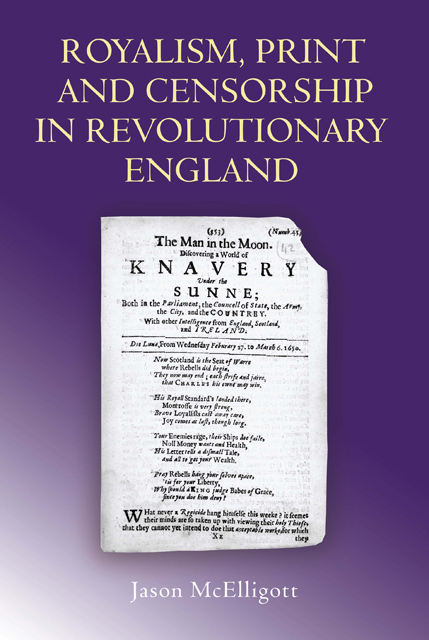Book contents
- Frontmatter
- Contents
- Illustrations
- Acknowledgements
- Abbreviations
- Introduction: Royalism and its Problems
- 1 Royalists and Polemic in the 1640s
- 2 The Politics of Sexual Libel
- 3 The Twists and Turns of Royalist Propaganda
- 4 Authors, Shifting Allegiances and the Nature of Royalism
- 5 Printers, Publishers and the Royalist Underground
- 6 Hunting the Royalist Press
- 7 The Theory and Practice of Censorship
- 8 A New Model of Press Censorship
- Conclusion
- Select Bibliography
- Index
4 - Authors, Shifting Allegiances and the Nature of Royalism
Published online by Cambridge University Press: 10 March 2023
- Frontmatter
- Contents
- Illustrations
- Acknowledgements
- Abbreviations
- Introduction: Royalism and its Problems
- 1 Royalists and Polemic in the 1640s
- 2 The Politics of Sexual Libel
- 3 The Twists and Turns of Royalist Propaganda
- 4 Authors, Shifting Allegiances and the Nature of Royalism
- 5 Printers, Publishers and the Royalist Underground
- 6 Hunting the Royalist Press
- 7 The Theory and Practice of Censorship
- 8 A New Model of Press Censorship
- Conclusion
- Select Bibliography
- Index
Summary
Rethinking royalism and political allegiance
The nine known authors of the royalist newsbooks are John Berkenhead, John Cleveland, John Crouch, John Hackluyt, Marchamont Nedham, Martin Parker, Samuel Sheppard, John Taylor and George Wharton. There may have been a number of other men involved in a peripheral way in the writing of these serials, but the desire of the authorities in London to track down the culprits, the particular skills necessary to write and edit a newsbook, the size of the egos necessary to undertake such a dangerous task, and the benefits to be gained after the Restoration by identifying oneself as a royalist partisan during the 1640s suggest that these nine men constituted the essential nucleus of the royalist propaganda effort.
Some of these men were more active than others, and the activity of all of them varied greatly over time as they became enthused or disappointed by events, were forced to spend long periods in hiding, or were captured and imprisoned by their enemies. The age of the famous ‘water poet’ John Taylor (he was over 70 in the late 1640s) may have ensured that he was less active than some of his younger comrades, and it is possible that the famous royalist balladeer Martin Parker actually played little or no part in the production of the royalist newsbooks. Parker's biographical details are vague, but there are some unsubstantiated suggestions that he died some time in 1646 or 1647, and the association of his name with the newsbooks may have been no more than an attempt to link them with a famous author who was known to have produced best-selling works in the past. On the other hand, there are a number of contemporary suggestions that Parker did participate in the writing of the newsbooks. We simply know too little about the lives and careers of most of these men, an unfortunate state of affairs due partly to their humble status as mere writers and propagandists, and partly to their understandable desire to leave as few clues as possible as to their identity and movements.
- Type
- Chapter
- Information
- Royalism, Print and Censorship in Revolutionary England , pp. 93 - 126Publisher: Boydell & BrewerPrint publication year: 2007

